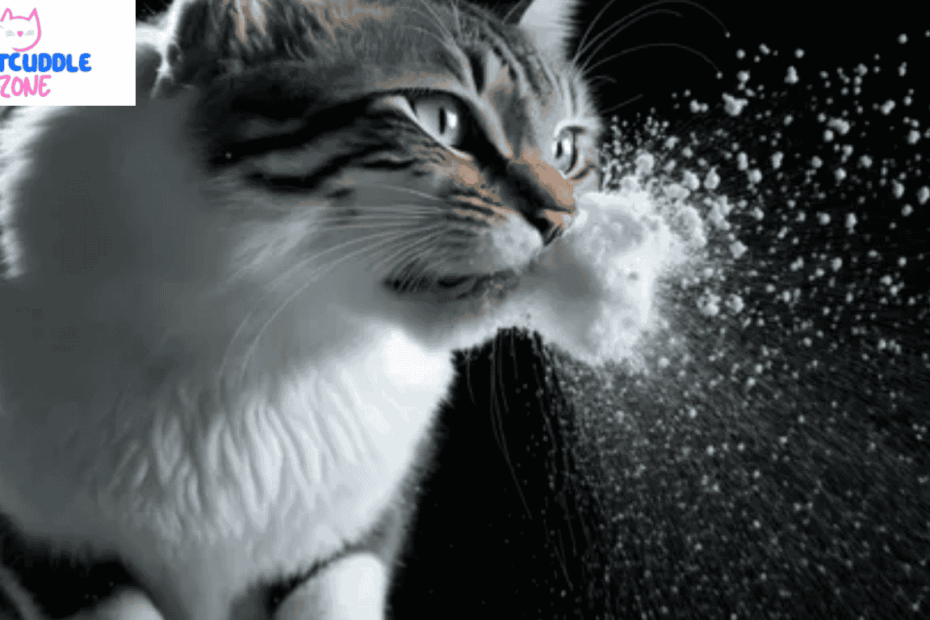When you see your cat throwing up white foam, it can be both alarming and confusing. Many pet parents wonder if cat vomit foam is simply a minor stomach issue or a sign of something more serious. The truth is, this condition may result from simple causes like morning vomiting in cats due to an empty stomach, or it could point toward deeper cat digestive issues. In some cases, what looks like a harmless incident may actually be linked to long-term problems such as cat upset stomach from diet changes or illness. Understanding the reasons behind foam vomiting helps you know when to act quickly and seek proper care.
What Does It Mean When a Cat Throws Up White Foam?
When your cat foams at the mouth what you are witnessing is usually a combination of stomach acids and mucus. The reason of this foamy nature is that the stomach is empty and irritation is built. It is not unusual, however, when your cat keeps foam-spitting, it may be an indication of more severe cat digestive problems.
In plain words, the foam indicates that there is something in the stomach or digestive system of your cat that is not functioning correctly. In some cases, it is associated with vomiting in cats in the mornings, also known as why cats vomit on empty stomach, although it may also indicate more serious conditions such as gastritis or inflammatory bowel disease (IBD).
Common Causes of White Foam Vomiting in Cats
The commonest cause is a vacant stomach. Cats vomit in the morning because of the accumulation of acids in the night. That is the reason why you can find your cat gagging or retching before breakfast. The other one is also due to hairballs during the act of grooming that irritates the stomach leading to cat barfing white foam.
Causes are also found in the cat upset stomach due to change in diet, cat sick after eating spoiled food and allergies. Parasitic infections or such diseases as kidney disease, liver disease, pancreatitis or hyperthyroidism can all be the causes of cat keeps throwing up foam.
Vomiting vs. Regurgitation: How to Tell the Difference
The two are mixed up by many pet parents. Vomiting is a dynamic process. What you will hear is the tightening of the body of your cat, which is then gagged or retched before the foam or food rises to the surface. Regurgitation is otherwise; it is a passive process in which the food or the liquid is forced back without any effort.
This difference is important, as the regurgitation usually indicates the issues with the esophagus, whereas cat vomit foam originates in the stomach. This fact can assist your vet select the correct diagnostics which can be a physical examination, x-rays or endoscopy.
Acute vs. Chronic Vomiting in Cats
Acute vomiting happens suddenly. For example, your cat might vomit once after eating spoiled food. This is usually short-term. On the other hand, chronic vomiting keeps coming back, lasting weeks or even months. Chronic vomiting is far more serious.
When a cat throwing up but acting normal, it could be acute and minor. But if the foam vomiting continues for days, it falls into chronic territory. Long-term cases often relate to deeper issues such as IBD or pancreatitis.
Symptoms to Watch for Alongside White Foam
If your cat vomits foam, look for extra warning signs. Lethargy, loss of appetite, and weight loss show that your cat isn’t just having a minor stomach upset. Sometimes, cats may also develop diarrhea along with vomiting.
Severe dehydration is another red flag. You can check this at home using the skin tent test. If your cat’s skin stays raised after being gently pulled, it signals low fluids. Combined with cat spitting up foam, this requires an emergency vet visit.
When to Seek Veterinary Care Immediately
Occasional vomiting may not require worry, but repeated foam episodes need quick help. If your cat shows blood in vomit, lethargy, weight loss, or dehydration, call your vet right away. These signs are linked to serious feline health conditions.
Don’t wait if your cat refuses food for more than 24 hours. Cats cannot go long without eating safely. Getting an emergency vet to run a professional diagnosis may be the difference between quick recovery and severe illness.
How Vets Diagnose Vomiting in Cats

The first thing that your vet does is to examine your cat physically and review his daily routine. Inquiries on diet, domestic modifications or feline nutrition enable them to hone down the problem.
In this case, laboratory tests, blood tests, and X-rays or ultrasound are used afterwards. In case of obstruction, endoscopy can be carried out. These devices enable vets to peep in the digestive tract and detect concealed issues in cat digestive tracts.
Treatment Options for Cats Throwing Up White Foam
In case the issue is not severe, it can be treated at home. Distressing vomiting can be relieved by feeding small meals frequently, promoting fluid intake, and eliminating stress-associated vomiting. Vets can also recommend the easy management diet such as changing to wet or hypoallergenic food.
In severe instances, antacids, anti-nausea, antibiotics and fluid may be administered. In case it is caused by chronic disease, long-term care plans are drawn. This can take the form of prescription diets and frequent veterinary visits to ensure that the cat is well.
Prevention: How to Keep Your Cat’s Stomach Healthy
Constant care is the most effective in preventing cat throwing up white foam. Cat bile vs foam vomit is prevented by proper feeding schedule and hairballs are controlled by conducting regular grooming. Foam vomiting can be prevented by brushing long-hired cats on a daily basis.
Hydration is vital. Lots of cats do not like water bowls, there is a use of fountains or wet food. To this normal stress-cutting, play, and regular veterinary check-up, add it up and you will enhance the feline health of your cat in the long-run.
What To Do If Vomiting Continues
Never overlook, when cat continues spewing foam after adjustments have been made. Diseases which may be hidden in chronic cases include IBD, kidney disease, or pancreatitis. The cause can only be verified with the help of the right lab tests by a vet.
The important thing in such cases would be to adhere to a long-term management plan. Your vet could take you through diet change, diet control, or drugs. Monitoring behaviors at home assists them to modify the treatment with time.
Final Thoughts on Your Cat’s Health
Nobody would want to see his/her cat sick. When you see cat barfing white foam, you should pay attention. Even though certain cases are not harmful, there are cases that require urgent attention.
You can help as a pet parent by being vigilant and intervening when necessary and helping your cat towards a healthier feline life. Through proper care, intelligent prevention, and regular vet check-ups, you would be able to make your cat happy and stop the constant vomiting issues.
Quick Reference Table: Causes and Solutions for White Foam Vomiting in Cats
| Cause | Example Signs | Possible Solution |
| Empty stomach | Morning vomiting in cats | Feed frequent small meals |
| Hairballs from grooming | Coughing, foam + fur | Regular grooming, hairball remedies |
| Gastrointestinal issues | Cat upset stomach, pain | Vet exam, possible antacids/medications |
| Serious illness (kidney, IBD) | Weight loss, lethargy | Diagnostics, long-term management |
| Stress or anxiety | Stress-related vomiting | Stress reduction, routine care |
Frequently Asked Questions
What should I do if my cat is throwing up white foam?
Offer small meals, keep them hydrated, and see a vet if it happens often.
Is foamy saliva serious?
Yes, it can signal nausea, stress, or underlying illness, so monitoring is important.
Is foamy vomit an emergency?
If frequent or with symptoms like lethargy or weight loss, treat it as urgent.
Does acid reflux cause foamy spit?
Yes, acid buildup can irritate the stomach and lead to foamy vomit.
What causes foamies?
“Foamies” often happen from an empty stomach, hairballs, or digestive upset.
